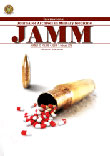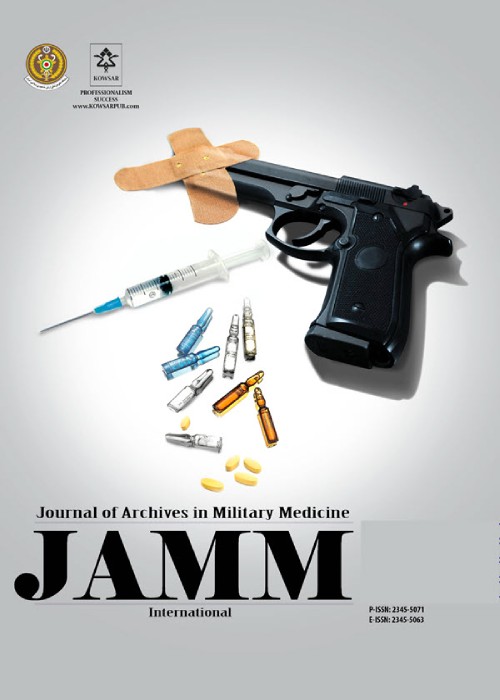فهرست مطالب

Journal of Archives in Military Medicine
Volume:4 Issue: 3, Aug 2016
- تاریخ انتشار: 1395/07/10
- تعداد عناوین: 6
-
Page 1BackgroundSodium hypochlorite (NaClO) is a chemical compound that is widely used in bleaching, stain removal, disinfection, deodorizing and water treatment. Sodium hypochlorite-induced chemical burns have been described and are reported as relatively rare. We report our experience with such cases to illustrate important points regarding management of these burns.MethodsWe retrospectively collected the data of NaClO-induced upper extremity chemical burn admissions at a military hospital during an eight-year period (2007 - 2015). Survey data included patient age, gender, burn area, burn depth, treatments and follow-up period.ResultsEight patients were admitted to our emergency department with complaints of NaClO-induced chemical burns of the upper extremity of skin over an eight-year period. All of the patients were male, with a mean age of 21.25 (19 - 23) years. Four of the burns were diagnosed as second-degree deep dermal chemical burns and the other four were second-degree superficial dermal chemical burns. Two of the patients with second-degree deep dermal chemical burn underwent debridement and skin grafting. All of the patients were then followed for three to nine months.ConclusionsWe recommend the use of tap water for high-volume, long-term lavage. We are against using neutralization chemicals in order to prevent more unforeseeable catastrophic effects, because it is difficult to determine the composition of exposure from NaClO-derived household chemicals. After emergency department evaluation, patients should be hospitalized for at least the first 24 - 48 hours, according to the plastic surgeons decision.Keywords: Sodium Hypochlorite, Chemical Burns, Emergency Servic
-
Page 2BackgroundOne of the important risk factors for insulin resistance is stress and a major source of stress is job stress.ObjectivesThe current study aimed to determine the relationship between job stress score and insulin resistance among medical staff of the Imam Reza hospital, Tehran, IranMethodsThe current descriptive cross-sectional study was performed on 97 medical staff of Imam Reza hospital, Tehran, Iran. The Osipow questionnaire was used to assess the level of occupational stress. Insulin resistance was calculated according to the formula: fasting insulin (microU/L) × fasting glucose.ResultsThere was no significant difference in insulin resistance among the hospital staff. Job stress was significantly higher in the intensive care unit staff than the staff of other departments (PConclusionsThe intensive care unit (ICU) staff was exposed to more stress than the staff of other departments. But there was no relationship between job stress and insulin resistance among hospital staff. Further studies are needed to evaluate the relationship between job stress and insulin resistance.Keywords: Stress, Insulin Resistance, Medical Staff
-
Page 3BackgroundOsteoarthritis (OA) is one of the most common diseases of both bone and cartilage. Since calcitonin may have positive effect on both of them.ObjectivesThe current study aimed to evaluate the effect of weekly calcitonin injection on patients with knee osteoarthritis using Western Ontario and McMaster universities arthritis index (WOMAC) questionnaire.MethodsThe current prospective cross sectional study, randomly recruited 28 eligible female participants aged 55 - 70 from outpatients referred to rehabilitation clinics. These patients were in stages II and III based on Kellgren-Lawrence grading scale. Patients were requested to fill out the multidimensional WOMAC questionnaire on the day of enrollment into the study (baseline examination) and five weeks after completion of their treatment with calcitonin. Paired T-test was used to assess mean differences of the questionnaire.ResultsCompared to baseline, significant improvement in WOMAC score was observed after five weeks of treatment. Pain, joint stiffness, functional activity and total score of WOMAC showed improvement of 80.6%, 25.3%, 41.9% and 47.91% respectively, which were statistically significant (P valueConclusionsThe study results showed that calcitonin can provide proper outcomes such as increased locomotor activity. Although WOMAC parameters increased in all age groups, it had great effect just on 55 - 60 years age group. Therefore, improvement of quality of life and proper rehabilitation, which are the main factors in osteoarthritis patients, were almost achieved in this study.Keywords: Knee Osteoarthritis, Calcitonin, Pain Assessment, Rehabilitation
-
Page 4BackgroundSoldiers are returning from military service with physical and/or emotional injuries that impair health and overall physical functioning. To address this limitation these Soldiers are assigned to Warrior Transition Battalions (WTB)..ObjectivesThis proof of concept study evaluated the impact of an individualized Agility Program (AP) on the physical functioning of 11 Soldiers assigned to a WTB at a Midwest military base..MethodsA pre-post design was used that assessed four fitness domains (cardiovascular function, agility, mobility and balance) before and after six weeks of two days per week training. Cardiovascular (CV) function was measured by the 6-Minute Walk test, agility by the Illinois Agility test, mobility with the Up and Go test, and balance by Single Leg Stance test. Modifications for the AP were individualized for each participant based on their medical history and current health status..ResultsResults indicated significant improvements in the 6-minute walk test (P = 0.05), Illinois Agility test (P = 0.022), Up and Go test (P = 0.002), and single leg stance test (P = 0.027). Soldiers assigned to a WTB may see physical fitness improvements through participation in an individualized AP..ConclusionsThis improvement in CV function, strength, agility and balance has the potential to result in better health and improved overall physical functioning..Keywords: Physical Fitness, Warrior Transition Battalion, Soldier Training
-
Page 5BackgroundExercise therapy is commonly used for treatment of chronic low back pain. Evidence for efficacy of most exercise therapy modalities is weak or lacking. This study aimed to execute a high-quality, clinical trial of a single innovative new home exercise (Farshad exercise) to determine the efficacy for treatment of chronic non-specific low back pain patients.MethodsPatients: The cases included chronic non-specific low back pain patients aged between 19 and 64 years, with pain of at least three months in duration. Patients had no significant signs or symptoms of lumbosacral nerve impingement, malignancy, spinal stenosis, or mood disorders. The study design involved CT with 113 subjects. Samples were stratified by workers compensation claim (yes vs. no), and use of opioids. The null hypothesis of this study was no statistically significant improvement in function of patients during and at the end of the 12-week treatment period. Data collection: subjective data were collected using database management collection tools. Objective data were obtained through functional assessments. Data were collected at enrollment (baseline) and on the fourth, eighth, and twelfth week for each participant by a blinded assessor. Intervention: A new home exercise was designed by the author (Farshad exercise). Each patient had identical numbers of visits (4) and researcher contact time (approximately 15 hours).ResultsThe primary outcome measure was the Oswestry disability index. Secondary measures included visual analog scale (VAS) pain score. Outcome measures were assessed at baseline (0), fourth, eighth, and twelfth week. Treatment failure was defined if the patient terminated treatment for non-efficacy or underwent invasive procedure or other excluded co-interventions.ConclusionsStudy strengths included controlling for co-interventions, rigorous inclusion criteria, assessment of compliance, plans for limiting dropout, identical assessment methods and timing.Keywords: Chronic Low Back Pain, Exercise Therapy, Home Exercise


